“The Practical Joker”
Written by Chuck Menville
Directed by Bill Reed
Animated Season 2, Episode 3
Production episode 22021
Original air date: September 21, 1974
Stardate: 3183.3
Captain’s log. The Enterprise is finishing its asteroid mapping expedition 72 hours ahead of schedule. As they approach the last asteroid, they’re ambushed by three Romulan ships. The Romulan commander insists that the Enterprise violated the Romulan border, which Kirk denies.
Sulu detects an energy field—one not on Spock’s charts—and Kirk has him fly through it in the hopes of losing the Romulans, at which it succeeds.
Later, in the captain’s mess, Scotty reports that the repairs are proceeding apace. McCoy toasts their narrow escape, and everyone’s drink spills on their tunics, and Kirk’s fork becomes flaccid. McCoy figures it’s a practical joke like they used to do in medical school, but since everyone was affected, and no one’s taking credit, it could be a glitch in the food synthesizers.
The practical jokes continue. Spock gets dark circles around his eyes from a microscope that inexplicably shows up on his console, Scotty is buried in a ton of food in the mess hall, culminating in a pie in the face, the captain’s uniform has “KIRK IS A JERK” stitched onto the back, and a deck has been covered in ice.
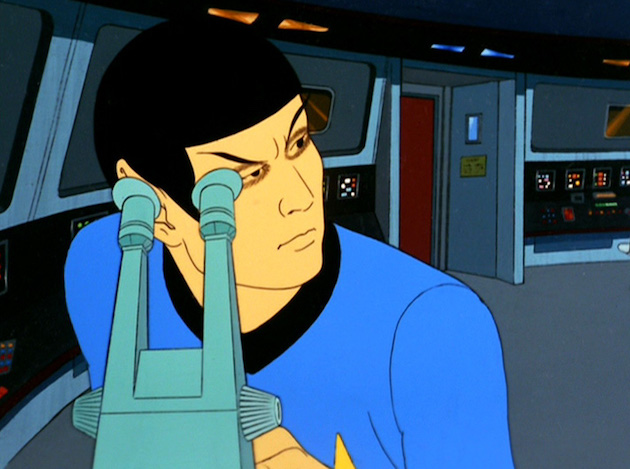
They also keep hearing a specific laugh over the intercom. Spock hypothesizes that it’s the ship’s computer, mainly because the laugh over the intercom is the same voice as that of the ship’s computer. (And also the same voice as Chapel and M’Ress, but we’ll let that go…)
McCoy, Sulu, and Uhura head to the rec deck to relax off duty. Sulu programs a walk in the woods. Spock calls all personnel to their stations, but the call doesn’t make it through to the rec deck. And the trio become victims of a practical joke in the rec deck.
Kirk has Spock query the computer as to why the three on the rec deck are incommunicado, and the computer proceeds to snark off both Spock and Kirk. Kirk orders Scotty to disable the computer’s logic functions, but before he can, the computer reverses gravity. Once Scotty vacates the computer room, via crawling on the ceiling, gravity is back to normal.
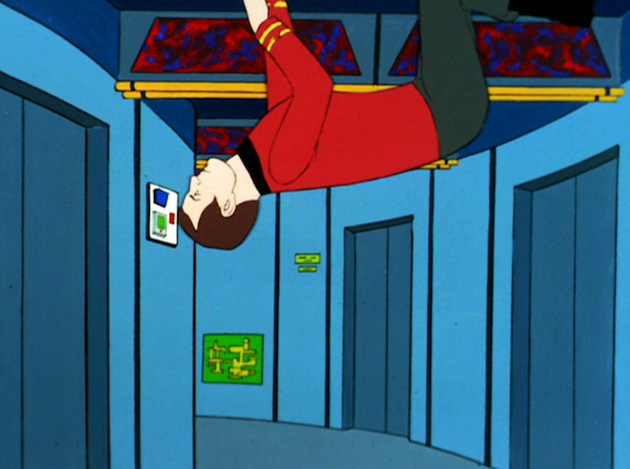
On the rec deck, the computer changes the setting from a pleasant woodland to an arctic blizzard in order to “cool off” their anger. They can’t see anything, including the console or the exit, so they simply move in a single direction until they reach a wall.
Security can’t get through the rec deck doors, but just as Kirk is about to have Scotty send a work crew there, everyone (except Spock, of course) starts laughing. The computer is pumping nitrous oxide into the air. Spock manages to kill the air circulation, but now they have a ticking clock—the air will run out in six hours.
Scotty’s work crew can’t get the rec deck doors open with power tools, but they manage to crowbar the doors apart and rescue McCoy, Sulu, and Uhura.
Spock’s theory is that the energy field they went through gave the computer the equivalent of a nervous breakdown. Scotty tries to shut down the engines, but all controls are frozen out, and the computer changes course back toward the Romulan Neutral Zone. The three Romulan ships detect them and move to intercept—but then the computer kicks out the giant inflatable Enterprise decoy (just go with it), which gives the Romulans pause.
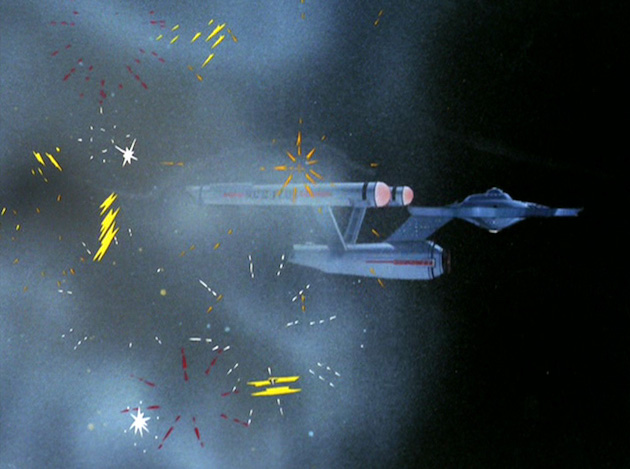
Kirk realizes that the computer is playing a joke on the Romulans. They attack the decoy and destroy it, only to discover that it’s a fake. The Romulans again move to intercept the Enterprise.
Suddenly, Kirk seems to be gripped with fear of the energy field. He expresses how incredibly scared he is of it, which prompts the computer to head straight for it. Going through it a second time resets the computer back to its normal self, er, somehow, and all is right with the world.
Well, except for the Romulans who tried to follow the Enterprise through the field. Now their computer is playing practical jokes on them…
Can’t we just reverse the polarity? Apparently the energy field can fritz a computer to the point where it develops a cruel sense of humor—and a second exposure somehow reverses it because plot.
Fascinating. Though he gives no specifics, Spock is genuinely worried about the effects nitrous oxide will have on his Vulcan physiology.
I’m a doctor, not an escalator. McCoy succumbs to the arctic cold in the rec deck before Uhura and Sulu do, and he asks Kirk to turn up the heat on the ship even after they’re rescued.
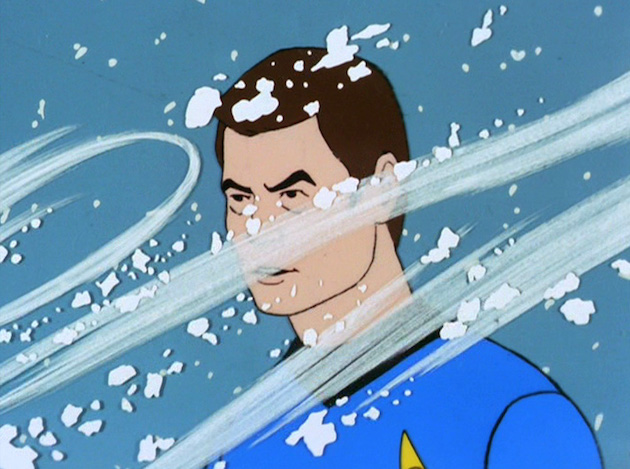
Hailing frequencies open. Uhura is trapped on the rec deck, so M’Ress handles communications while she’s stuck.
Ahead warp one, aye. Sulu is the one who finds the energy field, which gets them away from the Romulans but causes all the episode’s problems, so mixed blessing there, helmsman…
I cannot change the laws of physics! Scotty talks sweet to the ship when they’re trying to escape, then bitches the ship out once the jokes start.
Forewarned is three-armed. Oddly, Arex is seen sitting in the captain’s chair at one point, even though both Spock and Sulu are on the bridge.
Go put on a red shirt. Security can’t get the rec deck door open at first, but eventually they pry it open with a crowbar.
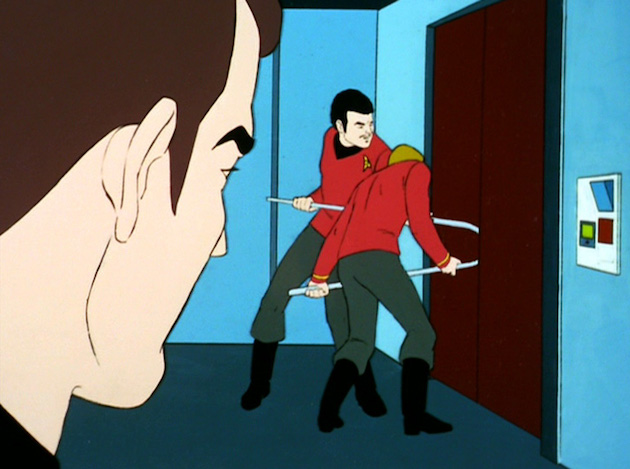
Channel open.
“Captain Kirk, look behind you!”
“Really, M’Ress, you’re going to have to be a little more clever than that.”
–M’Ress warning Kirk about the iced deck and Kirk being paranoid.
Welcome aboard. An unknown voice actor does the Romulan commander, James Doohan does his usual Scotty and Arex along with a couple of the extras, with George Takei as Sulu, Nichelle Nichols as Uhura, and Majel Barrett as M’Ress.
Trivial matters: The rec deck is a prototype of the holodeck that TNG introduced in “Encounter at Farpoint,” although future productions will ignore this particular innovation on Kirk’s Enterprise, speaking of holodeck technology as if it was new to the 24th century.
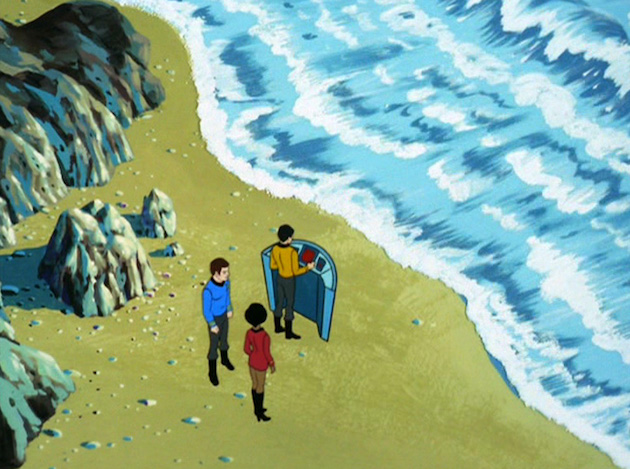
The inflatable starship decoy will be seen again in John M. Ford’s Trek novel How Much for Just the Planet?
While the Romulan commander does not specify when the Enterprise invaded Romulan space, it’s possible that he was referring to one of the previous times the ship entered Romulan territory and did not actually get punished for it: “The Deadly Years,” “The Enterprise Incident,” or “The Way to Eden.”
To boldly go. “Say pretty please with sugar on.” Parts of this episode are enjoyable. I like the idea of the holographic rec deck—and so did other people, since it became part of every Star Trek spinoff series that took place in this episode’s future. I freely admit that Kirk walking around the ship with KIRK IS A JERK on his back appeals to my sense of the absurd. I like seeing the crew relaxing on their off-hours—the senior staff dining together, Arex and M’Ress eating together and inviting Scotty to join them, McCoy, Sulu, and Uhura going on the rec deck together. And nobody ever went wrong with a pie-in-the-face joke.
But man, what a mess the episode is. My theory in the Trivial Matters section notwithstanding, there’s no reason given why the Romulans attack in the first place. The jokes are all incredibly unimaginative and very basic stuff. The dark-eyes-from-the-microscope thing doesn’t even make sense in the setting. (Why would there be a microscope on Spock’s console? How’d a disembodied computer even get it there?) They’re just variations on contemporary pranks, and not particularly interesting ones. Plus, there’s the completely absurd giant inflatable Enterprise decoy that the Romulans somehow don’t realize is a giant balloon until after they fire on it. I can’t even…
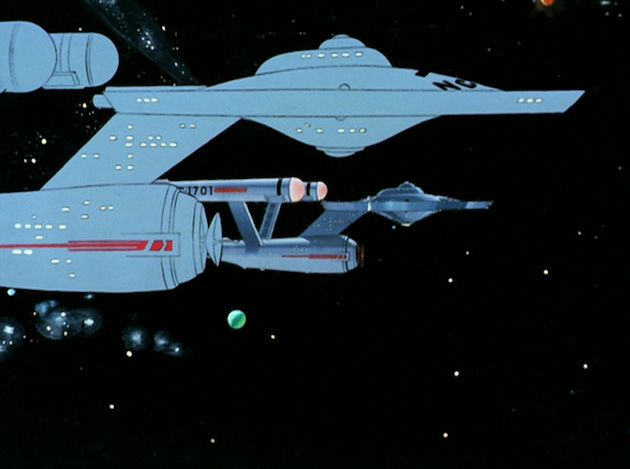
Also, the episode is particularly done in by the nature of how the voices are filmed. Group laughter works better when everyone’s together laughing with each other. Here, the laughter is obviously everyone recorded laughing separately, and it makes the whole thing incredibly awkward.
And then there’s the giant inflatable Enterprise decoy. Seriously.
While the solution in the abstract shows Kirk being clever, in reality there’s no evidence, none, to support the notion that flying through the energy field a second time would reverse the process and make everything better. In fact, based on how Spock describes the damage, it would make things considerably worse. And there’s no reason to assume that Romulan computers would even respond the same way.
Basically, it’s a lame excuse for a series of lame practical jokes, and it ultimately doesn’t work. Especially what with having a giant inflatable Enterprise decoy. Seriously, why the heck is there a giant inflatable Enterprise decoy????
Though Scotty does get a pie in the face. Which remains awesome.
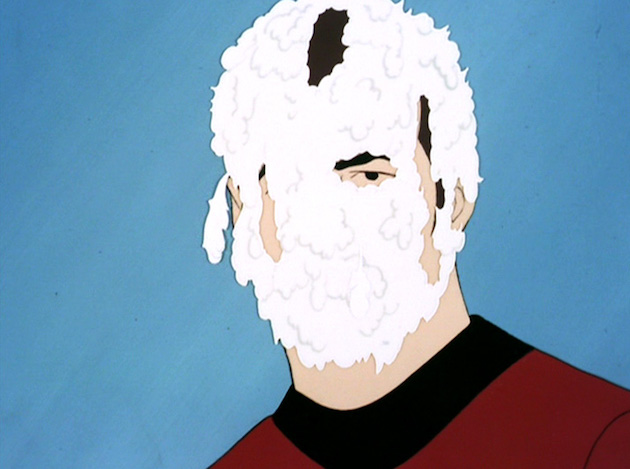
Warp factor rating: 3
Next week: “Albatross”
Keith R.A. DeCandido is running a Kickstarter for Mermaid Precinct, the long-awaited fifth novel in his fantasy/police procedure series, in which Torin and Danthres will be charged with finding out who murdered the legendary Pirate Queen. Please support it, as there are many nifty rewards, and there will be tons of nifty stretch goals!










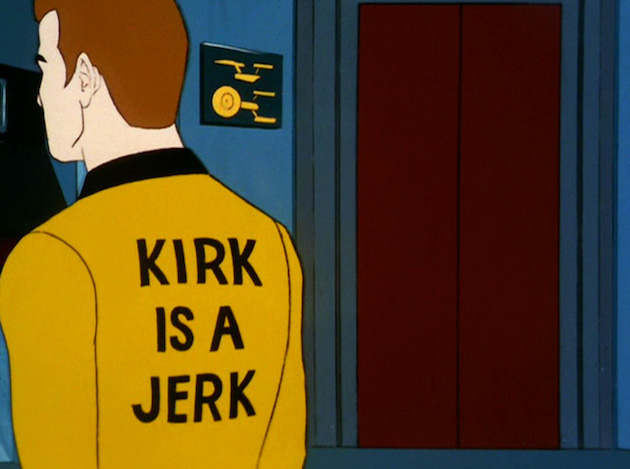
Why, yes, I am 12.
Why does Spock get black eyes from a microscope that inexplicably shows up on his console instead of, y’know, the freaking visor he has there and uses all the time? But the computer obviously transported it there.
Good thing it wasn’t an actual holodeck, or they could have been walking forever.
Is this Batman ’66?
Ah…Kirk is so freaking awesome, he had a malfunctioning holodeck before malfunctioning holodecks were cool!! I’ve always wondered–did the computer replicate that Enterprise balloon, or were they on their way to the Macy’s Thanksgiving Day Parade once they were done with their mission?
For some reason, I was remembering this not as a computer malfunction, but as some sort of alien entity possessing the computer, like Redjac in “Wolf in the Fold.” I was thinking that somehow the second trip through the field forced the alien back out of the Enterprise.
While the real explanation given, a sort of computer bacterial infection, makes a kind of sense as a cause of malfunctions, it doesn’t make sense as to how it would create the “joker” personality in the computer. It seems like the malfunctions would just increase in severity until the systems completely broke down. And it sure doesn’t make sense that a return trip through the field would make things “all better.”
Also, given the seriousness of the problems that arose on the Enterprise, Kirk’s decision to delay telling the Romulans how to get resolve their computer issues seems uncharacteristically cruel on his part.
This episode may have introduced a prototype holodeck but I am rather glad that giant inflatable starship decoys did not likewise become a regular feature in the spin-off series.
MaGnUs: I was tempted to put “wah-HEY!” after the flaccid-fork line, but I decided to at least have a modicum of maturity. Don’t worry, I’m sure it’ll pass….
—Keith R.A. DeCandido
Once again, Star Trek was ahead of its time https://en.wikipedia.org/wiki/AN/SLQ-49_Chaff_Buoy_Decoy_System
I’m not sure about the other guest voices, but the junior officer on the Romulan bridge is undoubtedly Lou Scheimer.
I’ve never been too fond of this one conceptually. I think it’s implausible that these intelligent people would laugh at such sophomoric jokes, and I agree that the way the problem is fixed makes no sense — it’s sitcom logic, like curing amnesia with a second bump on the head. And there’s no way a nonsentient computer could possibly understand something as cognitively complex as humor. I tend to assume that the real explanation is more like TNG’s “Lonely Among Us” — that the ship actually picked up some kind of incorporeal intelligence that infected the computer and that was drawn back out into the cloud on the second passage. Though that still doesn’t explain how Kirk realized a second passage would help.
Still, I found I actually enjoyed watching it this time. The second-season acting, pacing, and animation are all considerably improved from the first. This episode has a much livelier pace than a lot of prior ones, and despite the initial silliness, it quickly builds up to a palpable sense of danger. It actually succeeds better at suspense than it does at comedy.
In my recent TOS novel The Face of the Unknown, which is something of a transitional piece between TOS and TAS, I explain that the Enterprise got an experimental holographic recreation room from the First Federation during the events of the novel, and hint that Starfleet was wary about using alien tech and wanted to see if it was safe before adopting it more widely. The implication being that its near-fatal malfunction in this episode (despite being caused by a separate phenomenon) led Starfleet to abandon the technology for several decades. Evidently 24th-century Starfleet has gotten more blase about holodeck malfunctions.
Anyway, McCoy’s “Must have been one of the audio tapes rewinding” line is just so quaint-sounding today…
There’s actually a fair amount of real-world research into inflatable space structures. They make sense, because without gravity, there isn’t as much need for heavy support structures, and a spacecraft is essentially a pressure vessel anyway, so they would allow something like a small, lightweight space habitat to be packed in a compact form and launched fairly easily into orbit. Of course, they’d be designed with greater durability than the trick balloon here.
The music cue that accompanies the pile of food spilling out onto Scotty (listed as “Off Duty” on the recent Star Trek 50th Anniversary Collection soundtrack CD set) is perhaps my favorite piece of Ray Ellis and Norm Prescott’s music for Filmation. It’s actually the tail end of a longer cue from Lassie’s Rescue Rangers, a slow and thoughtful arrangement of that show’s main motif building up to that lively violin bit at the end, and it was also frequently used in Filmation’s Shazam, Isis, and Tarzan: Lord of the Jungle. (In fact, I associate it mainly with Tarzan — I have a memory of it accompanying some bit of comedy business with Tarzan laughing at his monkey friend N’Kima.) The closing comedy cue has been used in TAS before (notably “More Tribbles, More Troubles”), but I’m pretty sure it’s borrowed from some Filmation sitcom.
Diane Duane makes good use of the rec deck in “My Enemy, My Ally”
Strangely, the bit about Spock and laughing gas would be brought up again in Star Trek: 25th Anniversary, an adventure game released in 1991. In one of the episodes of that game (it was episodic, like the series and supposedly took place in year four of the five-year mission), Carol Marcus and her crew mistakenly created a plague that could genocide all Romulans. The Romulans got wind of this and invaded Federation space, captured her research station, and Kirk had to go rescue her. It was a well-done plot, especially when it was realized that Spock had also caught the plague she had created and McCoy had to work overtime in adventure-game fashion to get a cure.
During the game, you could mistakenly create a few chemical compounds and release them into the air, one of which was laughing gas. Doing so causes all the crew members except Spock to randomly spout jokes and fool around. It was fun and featured some great dialog.
You can also discover that Spock has a similar reaction to Tantalum bi-lithium thalo-dihydroxide (abbreviated TLTDH) and if you release THAT into the air, much hilarity ensues… especially if you have Spock, Kirk, and McCoy all high on their own versions of the stuff.
(I reviewed that game last year for a different site. Tremendously fun all the way until the end when it falls down flat because an impossible combat sequence.)
I loathe practical jokers (or “assholes”, to use the technical term for them) in real life. I feel considerably worse about them in fiction. Although I suppose the computer personality is technically “killed” when they reverse the process, so that is something. Normally I oppose the death penalty for practical jokers, because I think it is too lenient, but I’ll take what I can get. Still not the worst TAS episode though. This is how deep the barrel we’re scraping is, that this is not the bottom.
I did like the How Much For Just The Planet novel though.
@8/wiredog: I’ve always thought of Diane Duane’s version of the rec deck more as an elaboration on the Star Trek: The Motion Picture version. It did have some holographic capability, but that wasn’t all it was; it was more of a big, multilevel recreation complex with lots of different facilities, like what the TMP set suggested but taken even further. She seemed to set her early books in a nebulous period between TOS and TMP where the ship, uniforms, etc. were sort of in between the series and movie configurations, or perhaps were an idealized fusion of both.
Holy King Tut. One trip through the energy field and the computer goes bonkers. A second trip and it’s back to normal.
McCoy and cold weather just don’t mix. At least this time he was on the Rec Deck and not stuck in the past.
The joke played on Spock would have been better if there had been a ring around his face courtesy of his visor.
I never assumed Kirk knew in advance that the second trip through the energy field would make the computer normal again. I assumed he was just trying to bait the Romulans to follow, and “curing” the Enterprise computer was just a happy accident.
@13/richf: From Kirk’s line that “The worst thing you can do to a practical joker is to play a practical joke on them,” it does seem that his gambit was directed specifically at the computer (or whatever invasive life form we choose to postulate) rather than the Romulans.
Alan Dean Foster’s novelization makes it explicit that it was Kirk’s deliberate gambit to solve the computer problem, although Foster takes a bit of a dig at the script:
Filmation really liked inflatable stuff theres lots in their 77 Batman.
@15/roblewmac: As it happens, “The Practical Joker”‘s writer, Chuck Menville, co-wrote about a third of The New Adventures of Batman‘s episodes. So maybe he was the one who liked inflatable stuff.
“Roast me! Hang me! Skin me alive! But PLEASE, Brer Enterprise, don’t fling me in the briar patch!…I mean, energy field!”
The inflatable Enterprise really ruins this one.
I first assumed that the Enterprise had in fact trespassed into Romulan territory, that the titular practical joker had tampered with their navigational data and they were not where they thought they were. When it turned out that the practical joker had only been created by the energy field later on, I had to give up my theory.
At least the holodeck here doesn’t create people, only landscapes. Later holodecks seem to create and destroy sentient beings for recreational purposes all the time.
@18/Jana: Again, there is real-life research into inflatable space structures, so I’ve never understood what people’s problem is with the inflatable Enterprise. I mean, inflating something in vacuum would be dead easy, since there’s no external pressure to speak of to resist the inflation. So it wouldn’t take much internal pressure to inflate it. And it wouldn’t have any weight to make it sag. I think that if an inflatable starship decoy were made with a metallic material, like a Mylar balloon, it could work convincingly as a decoy starship for at least a few moments — because, despite what special-effects shots tend to show, ships in space would typically be thousands or millions of kilometers apart and detecting each other by sensor readings rather than naked-eye sightings.
As for TNG-era holodeck characters, the only ones that have ever been portrayed as sentient were Moriarty and the Countess Regina, and they were clearly exceptional. Voyager‘s EMH was the only other sentient Federation hologram depicted in Trek, though we saw non-Federation sentient holograms in VGR’s “Flesh and Blood.” Even with DS9’s Vic Fontaine, it was never made clear whether he was a sentient being or merely a very sophisticated game character programmed to break the fourth wall. I tend to think the intention was the latter. Even in “Badda-Bing, Badda-Bang,” the crew’s desire to help Vic is never portrayed as a sentient-rights issue, but more like the emotional attachment fans feel toward beloved characters that they’d hate to see killed off.
@5 – krad: Glad to hear it’s only temporary.
@7 – Chris: “Rewinding” is indeed very quaint today. I feel self-concious telling my son to “rewind” a movie or TV episode we’re watching, even though he loves 80s technology and wishes he owned a cassette player.
@9 – Joe: I loved that game.
@19/Christopher: I assumed that the inflated ship would give vastly different sensor readings from the real one. If that isn’t true, I take back my criticism.
As for holodeck characters, I’d love to agree with you, but I think it’s more ambiguous than that. The final conversation between Picard and McNary in “The Big Goodbye”, the “Will my wife and kids still be waiting for me at home?”, seems to imply that he might be sentient. DS9’s “Shadowplay” only really works if the holograms are real people (okay, they’re non-Federation too). And I’m not sure about the characters in Voyager’s Irish village program.
The practical jokes themselves are anything but funny, unless you’re 5 years old or less. The only reason they work visually at all is because the limited animation and character poses make the whole scenario surreal. I remember this episode mostly for indirectly introducing the forefather to the holodeck. And the crew is smart enough to walk towards a wall in order to escape.
If the episode is supposed be funny, it sort of works. But I find myself laughing more at Kirk’s sudden fear of reentering the cloud than any of the computer pranks. In a way, Spock’s Brain was funnier.
Naturally, my first instinct when watching this was alien entity possessing the computer. I’ve had computers become unresponsive due to virus infection, but this story treats the Enterprise computer as a sentient being, something that was never previously established on TOS or TAS lore.
And that makes no sense. This isn’t Data, with a positronic brain and the ability to learn and evolve (although future iterations of Starfleet computers would have at least some sentience in a few decades when one of them decided to cut Data off during a monologue; season 1’s Conspiracy).
To top it off, DS9 did the exact same story nearly 20 years later on The Forsaken with the whole O’Brien babysits the Cardassian computer subplot.
@21/Jana: Well, the whole idea behind the so-called Turing Test is that nonsentient AIs can be programmed to fake sentience convincingly. Fiction often misrepresents passing the “Test” as “proof” of actual intelligence, but Alan Turing actually called it “the imitation game,” since it was just meant to determine whether intelligent behavior could be mimicked convincingly, the idea being that learning how to simulate intelligence would help us begin to understand how real intelligence works.
So just because a holodeck character acts self-aware, that doesn’t mean it is. It just means it’s a well-programmed game character. The difficulty in figuring out where convincing emulation ends and real consciousness begins is why we had episodes like “The Measure of a Man” and “Author, Author.”
@23/Christopher: That’s what makes it ambiguous. Considering how easy it was to create Moriarty, all those characters could be sentient. We don’t know.
@24/Jana: It wasn’t that easy to create Moriarty. It was an exceptional event that required the holodeck to draw on extra power and processing reserves. Not only that, but Deanna could actually sense his consciousness, something she clearly considered exceptional in a hologram. Similarly, the Voyager Doctor’s sentience was portrayed on several occasions as an unstable expansion that his program wasn’t designed to handle and was almost destroyed by. And his program was one of the most sophisticated ones ever created in the Federation. So it just isn’t logical to assume that all ordinary holograms are sentient. Especially if they’re just game characters. There’s no reason the computer would allocate enough processing power for sentience to something that was just meant to be an NPC.
More to the point, this is fiction, so the characters are only sentient if the writers intended them to be. Most ST has treated AI sentience as a rarity, something that’s difficult to achieve and prone to collapse. Data is the only Soong-type or similar android (I count Rayna Kapec) to function at a fully sentient level and avoid cascade failure or insanity, and nobody knew how Soong did it. TOS androids were usually treated as “just machines” that were slaves to their programming. Ruk showed some signs of independent thinking, but Andrea was little more than a sexbot, and though Korby, Brown, and the Kirk-droid had copies of actual human consciousnesses, the script still assumed they were just machines and not really people at all. And the Mudd’s Planet androids were exceptionally limited and inflexible — really just drones controlled by a single, very simple-minded central AI. Rayna was the one unambiguously sentient android we saw in TOS, and it took Flint centuries of failed attempts to get it right.
So the idea that artificial sentience is easy just doesn’t fit the Star Trek universe. It could fit somewhere else, like in Star Wars (where droids generally seem to be sentient even though they’re treated like disposable machines), but not here.
@24/JanaJansen: But what reason do you have to think they’re sentient? The creation of Moriarty was explicitly portrayed as exceptional in-text; it’s a really strange reading to consider them all sentient.
I mean, I’ve played plenty of games where the characters expressed existential crises, but I’ve never thought those characters were sentient. I don’t see how McNary is any different from Celes, Marle, or Flowey.
Plus, consider this. In the universe of TNG, we have a fictional character named McNary who’s worried about his continued existence. In the universe of reality, we have a fictional character named McNary who’s worried about his continued existence. Why is the existential crisis evidence of McNary’s sentience within Next Generation’s reality but not evidence of McNary’s sentience within our reality? Given that the macroscopic universe is essentially deterministic, you can’t even really use an argument of noninteractivity; both of our actions are equally as predetermined as the fictional character of McNary within our reality, so predetermination isn’t an argument against sentience. Unless you also believe that McNary is sentient within our context in addition to within the show’s context.
@25/Christopher: But it was easy to create Moriarty. It only took one sentence by LaForge, and the computer did all the rest. You’re right about the extra power, though, so I guess that means McNary wasn’t sentient after all.
I know that artificial sentience is supposed to be rare. I think it’s inconsistent writing.
@26/Idran: I had the impression that “The Big Goodbye” was deliberately ambiguous about the subject. If I’m the only one who thinks so, I’m probably wrong. But in this case, what was the point of the final dialogue between Picard and McNary?
@27/Jana: Yes, it’s inconsistent, but that doesn’t mean it makes sense to toss out the rule in favor of the exception. The logical interpretation is that Moriarty is the anomaly, that the apparent “easiness” of his creation was a fluke, or that there was more to it than there appeared.
As for “The Big Goodbye,” yes, that final bit was meant to introduce a glimmer of philosophical ambiguity about the line between fantasy and reality. But by the same token, it was certainly not meant as unambiguous proof of holo-character sentience. It was just your standard “…Or is it?” tag. “We proved Bigfoot was a hoax — but what was that howl in the woods just now?” “The whole thing was just a dream… but doesn’t that guy over there look familiar?” Just a little wink to keep us wondering.
It’s far more likely that McNary’s question was just the response of a character programmed to react as if it were a real person, upon being faced with information outside the normal parameters of the game. After all, the McNary character was present when people like Picard and Data spoke of coming from another world and of the characters’ own world being fictional. “He” had observed Redblock and Leech fading from existence when they left the holodeck. So McNary’s question “When you’ve gone, will this world still exist?” contained no new ideas, but was essentially just a rearrangement of already established information — like a slightly more advanced version of the old ELIZA program that created the illusion of being a psychiatrist by just restating what people said in the form of questions and peppering in stuff like “And how does that make you feel?” ELIZA was a very simple conversation simulator, but it still fooled some people into thinking it was human.
And the line about whether his wife and kids would be waiting for him was probably just because he was programmed to act like a family man and make periodic references to his wife and kids. There were probably game scenarios where McNary would be threatened with death and be programmed to express worry about his wife and kids, and this was just the program’s attempt to adapt that response to the threat of erasure as a fictional character. It was far, far too simple to require intelligence as an explanation. We’re just very good at anthropomorphizing inanimate objects, projecting the perception of our own self-awareness onto the world around us, so it’s very, very easy to trick us with the illusion of sentience. That’s why it requires a lot more evidence than two seemingly self-aware questions from a game character.
@28/Christopher: That’s a good explanation, thank you! I guess the exception became the rule for me because both of these episodes were so memorable, and set so early in the show.
@20 MaGnuS: Really? I use the term “rewind” and “fast forward” TODAY, especially when referring to digital technology. How is that at all antiquated? You are rewinding digital instead of taped/physical footage and data, is all, but if need to rewatch Act 2 of a TV show and I am on Act 4, what am I doing to the PVR/DVD/stream if NOT rewinding?
I’m not that old but I bristle when people discard perfectly acceptable and accurate terms for ones only associated with “new” technology.
AND @14 CLB et al….I am not at all convinced of the Kirk manoeuvre to draw the computer into the energy field…but even less so its reaction. If Kirk wanted it to know he was SCARED of it…so what? Practical jokes aren’t meant to terrify, only to embarrass and ridicule. Kirk’s fear reaction should not have been a trigger for the sentient being with THAT motivation to do what it did. I see no reason to plant the fear aspect into the equation at all. That would have been appropriate for Redjac but not this thing.
“Rewind” is literally about re-winding a tape. It’s perfectly acceptable in today’s techmology for you and me because we used videotapes and audio cassettes, but people like my son (as vintage-stuff loving as he is) haven’t. It is still acceptable as a non-literal term, same as “dialing” a phone number, I guess.
@30/Lou Israel: Yes, you might refer to “rewinding” a digital file, but it wouldn’t make an audible noise in the process. A rewound audiotape would. That’s the anachronism.
And the episode had already established that the computer’s practical-joker personality had escalated to the point of active sadism. It froze ice onto the deck, which could’ve caused serious injury. It pumped the air full of nitrous oxide, which can cause oxygen deprivation in large doses, and which left the whole crew in danger of running out of air when Spock had to shut down the circulation system to stop it. It nearly froze McCoy, Sulu, and Uhura to death in the rec room. It had gone beyond embarrassment or ridicule to active cruelty and malice. So it made sense for Kirk to think that showing fear would play into its psychology, even if the rest of his plan didn’t make sense.
@32/CLB – Is it active sadism, or just carelessness? Is it actually out to hurt people, or does it think that falling is funny, and isn’t particularly thinking of potential injury? That’s what happens when somebody thinks it’s funny to trip another person IRL – they’re going for the laugh, not the broken bones.
@33/Meredith: Trapping three people in life-threatening Arctic conditions is not carelessness, it’s attempted murder. I believe Foster’s version clarified that the only reason it switched to the maze simulation was because they were getting too close to the exit and it wanted to prevent them from finding it.